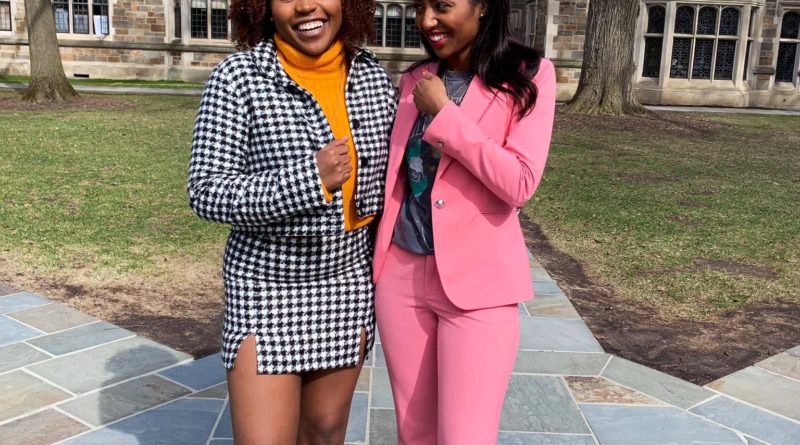The Style of Ann Arbor
This small college town has a surprisingly diverse look
–By Taylor Grier and Paris Parker
“Clothes mean nothing until someone lives in them.” —Marc Jacobs
Home to The University of Michigan, Ann Arbor is a dense cultural center of fashion and style. Indeed, Gianni Versace could have been describing Ann Arbor’s fashion scene when he said, “Don’t be into trends. Don’t make fashion own you, but you decide what you are, what you want to express by the way you dress and the way to live.” Instead of looking to social media and celebrities for the next trend to follow, fashion in Ann Arbor morphs together what’s popular with pragmatism and proximity. Each look is cultivated with a different perspective, and there is a slim chance of a dull fashion moment. Walking around Downtown, Central Campus and even North Campus, there is a unique charm to women’s fashion that is inspired greatly by Ann Arbor’s bursting microcosm of culture, college, and people. In this article, we examine some of the styles of the city, where students shop to find them, and how busy and budget-conscious students maintain their own unique style.
Looks of Ann Arbor
Even as the fashion temperature changes and trends become more variant, there are key looks that stand out as styles of Ann Arbor. These looks address shared interests, similar communities, and even occupation. On this campus, style is expressive of individuals who are fashion forward but also driven by practicality, and accessibility.

The University Style: Centralized around a vibrant and “bougie” aesthetic, this style is most notably linked with fraternity and sorority culture. From day parties to nights out, this style is significant for pairing edgy Instagram-inspired looks, with an aesthetically acceptable pair of dingy Adidas. Why? Because this style is a curation of looking effortless, fun and flirty while being mindful of muddy backyards, and needing a hat for the cold Michigan days. These unique and bold combinations feature fanny packs, sunglasses, and lots of denim. A great pair of jeans, denim jackets, Teddy bear coats, crop tops, jerseys and t-shirt dresses complete this look. Not afraid to show some pride, this style is great for tailgating and St. Patrick’s Day fun. It says, “I look good and you didn’t even notice the dirt on the back of my pants.” This style is inspired by the party culture that is a huge component of any college town. But this look transfers well into everyday class attire. Indeed, students often reuse key pieces for going out and seamlessly infuse them into their everyday wardrobe, allowing them to dress for class at four and a sorority event at six.
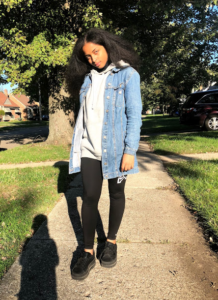
City Style: This style can be caught in almost any busy city, but Ann Arbor adds a chic and edgy flare. Notable for thinner silhouettes and longer lines, this style incorporates simplicity to capture a stylish effortless look. From platforms, booties, to a staple chunky scarf, this look has endless possibilities but comes in a few common colors. Nudes, muted earthy tones, and of course black makes this style a minimalist favorite. Good for almost any time of year, with this look, less is more. Solid basics such as a bold white tee, signature bomber, moto, pea coat or trench coat speak enough for any outfit. This style is inspired by a large number of students from the East Coast, New York, and New Jersey area. Bringing East Coast style to the Midwest is nothing short of exciting, even with the simplicity of the looks curated. Students explore comfort, and versatility through closet essentials while still making a fashion statement.
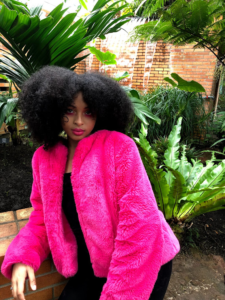
North Campus Style: Beyond “the hill,” North Campus is home of the art school and bursting creativity. Here, a more expressive and non-traditional, artistic style is common, combining aspiration, work, and personality all in one. Because of the heavy art presence, pre- and post-dancewear, film makeup, or even oversized flannels converted to art smocks are to no surprise well-integrated fashion. From vintage feminine aesthetics, such as prairie dresses, ruffles, and collars to clothing worn for practicality, there is a freshness to north campus that encourages trying new things. Thrifted jeans, paint as decoration, and florals are all easy components to any outfit. This style really is often a product of mixing volume and giving off body positive vibes with form-fitting silhouettes. UM, Student, Jessica Williams says, “I see more put together and higher-end clothing specifically shoes and jackets. In the winter I see a lot of nicely styled jackets and cute boots, it is different from traditional styles. These looks are probably inspired by SMTD and art students being influenced by their creative majors. On Central the style is a bit more relaxed; things like Ugg’s, gym shoes, jeans, and leggings are more common.”
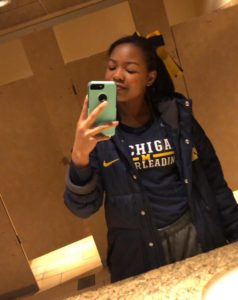
Athletic style: Michigan is the hub for phenomenal athletes, and these students never miss a beat with sporting their athletic gear regardless of having practice or not. The athletic style is often strutted by student-athletes on campus, but not exclusively. This style stands out for its school pride and well-crafted combinations of Michigan apparel. Whether rocking the traditional maize and blue, or school-issued apparel, this look is easy to spot and create. Indeed, dressing in Michigan gear from head to toe is a common look for many students. A strong athletic culture, especially a winning one, further drives this athletic style on a regular basis. And the best part, it never gets old. Cross trainers, parkas, backpacks, hats, warm-ups, and any good Michigan shirt are all perfect for a new athletic style look. This style widely speaks to a comfortability as well as practicality for many student-athletes—with practice varying at the beginning, middle, or end of the day dressing in this way allows for a seamless transition within the day.
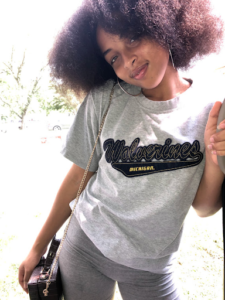
Athleisure: This style is similar to an athletic look; however, it has nothing to do with the University of Michigan necessarily and it is characterized by a sense of fashion forwardness. From crop tops, hoodies, comfy, joggers, and of course leggings, this style is a go-to look for being fashionably comfortable. Brands like Lululemon, Athleta, Alo Yoga, Fabletics, and Gymshark are notable for their stylish, chic, and high-quality athletic wear. This style encompasses the “rich” lazy look many students love to show off. Perfect to mix match and pair for any athleisure look these brands offer style and intention, without losing comfort. Many students who wear the athleisure style are not gym rats, but the fashionable look of the outfits make students look “healthier”. Similar to the athletic style, this style offers a smooth transition between from class to the gym, is full of options, and is effortless.
Online or in-store? Where students find their looks
But where does style come from? And what does it say about people and their habits? It is definitely much more than just fabric on bodies, even for those who dress out of necessity. This is because the styles that were once taboo, like an athletic look, or unique North Campus styles are now becoming embedded and embraced. Less do we see clones of students in the same cookie cutter looks, but instead, students inspired by their surroundings and looking within for their style inspiration; but where are they getting it from?
Students are often influenced by their connections—ties back home, house or dorm mates, clubs, teams, and even friend groups drive fashion choices. These combine and curate shopping culture in Ann Arbor. Many students have come to college loaded with clothing they previously owned, while others purchase entirely new wardrobes as they complete their undergraduate years. But eventually, they discover a niche store, style, or look that attracts looks and starts a conversation about their personal look.
These style choices frequently depend on both their budget and their access to clothing stores. Today with the growing online fashion world, students spend a lot of time shopping online. The number of packages in the dorm rises each day, as students refresh their style on various websites. We asked student resident advisor Victoria Lucas in South Quad about the number of clothing-based packages the dorm receives: she explains, “About 20% of the packages we receive are from online stores such as Urban Outfitters, Pretty Little Thing, and Nasty Gal.” Even though students are often shopping at the same stores, they still manage to find original looks, both because there is not a large “matching culture” on campus and because of the wide choices online shopping offers. Kori Scott, junior at UM, explains, “I have more options.”
As students continue to make many clothing purchases online, it is interesting to know 85% of people prefer to shop in store. But does that number reflect the students of Ann Arbor? Many students do shop in store for a variety of reasons, a common one is having the ability to try-on before purchasing. Kysia Jones, a student at UM, says she has to buy in stores because finding items that look cute on can be a challenge. She is not alone in her struggle, especially considering the limited shopping options close to campus. But there are some options. For the UM student, Urban Outfitters and RagStock are two stores near campus that students are particularly drawn to. Both stores offer students with trendy pieces that help curate their looks while offering items in an array of prices students can afford. Thrift and vintage shopping are another shopping choice of many Ann Arbor students; because they offer one of a kind pieces that keep the diversity of campus style afloat. Other students prefer the trendier stores like Pitaya and Verbena, which are pricier but offer fashionable pieces. Each of these stores and its wearers speaks to a different story of convenience and need. While students are making the switch online, there are still many reasons for students to shop in store.
What Do Stores Have to Do with Style?
College students are known for wanting to experiment with new things. Whether it be hair or makeup, fashion is a major area for exploration. The type of clothes Ann Arbor stores offer is why UM Fashion and Media professor Jimmy Draper believes that students are not shopping there unless they need to. He says most students are fulfilling their style needs by shopping online. Rachel Arseneault Garcia, UM Alum and freelance clothing stylist in New York notes that “The most important or influential way I have seen style and trends evolve since my time at UM (2009-2011) has to be the evolution of the internet, smartphones, and social networks/social media sites. Popular fashion bloggers were really the first “influencers,” the beginning of what we see on Instagram today. These blogs really focused on High-Low fashion, showcasing accessible trends but also wealth. I think to focus on the high-low, which is where we are now as extremely fast fashion, trend driven, industry, is what sparked this.” While Ann Arbor stores lack a range of style, Urban Outfitters is one notable store that gives students diverse options. Fulfilling all style needs on campus can be a pain when there is small access to stores that help reach certain looks. Clothing stores in the area make or break many student’s abilities to add new statements to their wardrobe. Though it is important to have a small number of shops on campus rather than none because window shopping can inspire students to make purchases elsewhere.
Lifestyle + Style
Many students wish they could make everyday a fashion show; but with tight schedules—and often budgets—University of Michigan students typically are not dressing up every day for class. However, there are some outliers who have the joy of dressing up or nice every day. How do they manage?
First, looking into the socioeconomic status of students, it should be recognized that money affects fashion. Professor Draper explains how class status at the University is prevalent and is showcased through the clothing choices of students. Having money to afford clothing that embodies a specific style can be difficult for some, though there are many students who sustain luxury. Student Taylor Brooks, for example, adds luxury to her style by buying “essential things like belts and rain boots.” These are pieces that cost a lot but can be used repeatedly because these typically use higher quality material. Students who can afford luxury items more easily have a timeless style, where they can wear a piece without it being on trend.
Students with less disposable income often sustain their style through other methods. Some students share that catching sales or finding second-hand shops helps them express their styles for less. A student with low funds, cannot always incorporate expensive trends, but having an interest in fashion can enhance students’ style on any budget. Mixing low funds and fashion allow students to expand their wardrobe by thrift shopping and upcycling different pieces. Many students are finding ways to take cheaper clothing and make them work seamlessly with whatever style they want to portray.
Students’ majors even fixate the type of clothing students can wear, altering their style. Student Victoria Lucas shares that although she would rather wear heels and makeup to express her style, as a pre-med student those items are not much of an option; she instead opts for “athleisure” because she can be comfortable moving around campus. Similarly, Ross major Kori Scott, although many may think she wears business casual every day, says, “I often wear leggings or sweats because I don’t have much time to get ready in the morning.” Style fluctuates for students because of the rigor of courses, regardless of what these students want to showcase as their actual style.
Extracurriculars a student wants or has to participate in, play a role in the style choices they make each day. Students with jobs on campus often dress a certain way to class because they have to dress for work. Dining service workers have to wear jeans when clocking in. Wearing jeans to class daily because of work is one-way lifestyle affects style. Student-athletes wear athletic wear to class because their practices require these. Both may want to dress differently, yet the lifestyles that assist their time at the university cause for their styles to be shifted from their norm.
When students have fewer commitments on campus or ones that do not require a specific wardrobe, they have the freedom to express their unique style. Looking at some of these students, they are typically dressed nicely because they do not have other obligations that force them to change up their clothing each day.
So, what is the style of Ann Arbor?
It’s still difficult to answer unless we include every daily outside factor that students deal with that affect their style choices. Some say the University of Michigan campus portrays a laid-back style when it comes to clothing because there is no pressure to dress up. Leggings and joggers become staple style pieces for many students. But others say that the campus portrays a “bougie” and expensive style. Which can be seen especially in the winter when fancy outerwear (e.g., Canada Goose) is spotted around campus. With over 44,000 students from all over the globe, it is inevitable that the fashion scene will not be easy to describe. More students are becoming carefree about their style, creating a diverse fashion culture on campus. Whether on Central or North, with a campus this big, there is no reason one can’t find their own personal style.
Featured Photo, courtesy of Jasmine Williams: Two women smiling outside of University building in business casual.

